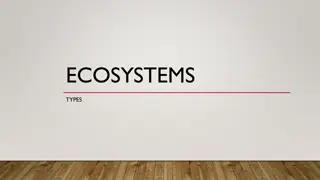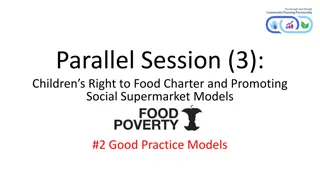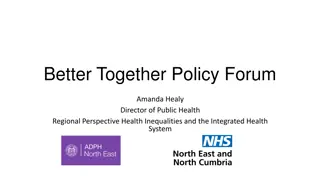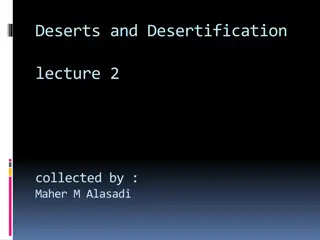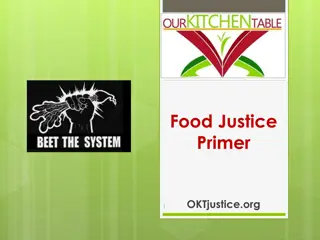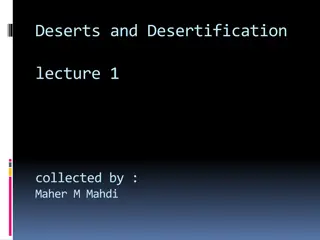Integrated Plan to Combat Food Deserts in Virginia
Virginia Executive Institute's Fall 2017 Cohort has developed an integrated plan to address the issue of food deserts in Virginia. Defined as areas with limited access to affordable and nutritious food, these deserts contribute to the obesity epidemic and various health concerns. Research findings highlight the prevalence of food deserts in both urban and rural areas of Virginia. The impact includes high childhood obesity rates and anticipated increases in diabetes and heart disease cases by 2030. Recommendations include a collaborative effort to tackle this critical issue.
Download Presentation

Please find below an Image/Link to download the presentation.
The content on the website is provided AS IS for your information and personal use only. It may not be sold, licensed, or shared on other websites without obtaining consent from the author. Download presentation by click this link. If you encounter any issues during the download, it is possible that the publisher has removed the file from their server.
E N D
Presentation Transcript
Virginia Executive Institute An Integrated Plan to Combat Food Deserts VEI Fall 2017 Cohort Jeremiah Fitz, Department of Corrections Arleen Green, Department of Taxation Karen Kimsey, Department of Medical Assistance Services Scott Ridgely, Virginia College Savings Plan Allen Wass, Department of Behavioral Health and Developmental Services
Definition of a Food Desert Areas where people cannot access affordable and nutritious food and/or Localities with limited proximity to supermarkets combined with low rates of vehicle ownership.
Health Concerns of a Food Desert Food deserts contribute heavily to our nation s obesity epidemic Major contributor of childhood obesity Increasing health care costs
Food Desert Facts 22% Households in low income urban areas live to 1 mile from supermarkets with no access to a vehicle. 23.5 million Americans live in areas with little to no access to fresh affordable foods. 20% Of rural households live more than 10 miles from the next supermarket. 17.8 % 1.7 million Virginians live in areas of limited supermarket access.
Whats the Impact? Health Financial Virginia Ranked No. 1 in childhood obesity for ages 2 to 4 among low income households As of June 2017 reported in the Richmond Times Dispatch Taxpayers left paying for more government spending on health care and less on the core functions of government By 2030 more than 1 million diabetes cases and 2 million cases of heart disease are anticipated
Primary Research into Food Deserts Interview with administrators in rural areas to gauge problems in Southwest Virginia Survey conducted amongst teachers in Richmond s Public School system to better understand the issues facing students in Urban areas Video summary of findings from survey
Food Desert Recommendations Explore a Collaborative Effort between VADOC, VADOE and VADOH to combat this crisis VADOC has the Farmland that can be utilized to harvest the crops VADOE can strategically place drop off sites for fresh produce in schools/communities where the food desert exist VADOH can help provide community education on the healthy living implications of eating right Combining resources and an emphasis on strategic planning that includes food deserts as a health crisis from an inter-agency perspective
Food Desert Recommendations Declare the elimination of food deserts a strategic plan priority for key agencies to incentivize companies to participate e.g., Virginia Development Economic Partnership Promotes enhanced collaboration among the Secretariats Expanded development private/public partnerships Education, strategic planning and support to local grocers Amazon delivers to homes through USPS Local grocery stores now starting delivery options (Publix, Kroger, Wal-Mart)
Food Desert Recommendations Automatically enroll eligible Medicaid beneficiaries into the SNAP program, with a simplified renewal process
Appendix - Survey Questions Overall, what impact do you believe lack of nutritious foods have on students ability to learn? Extremely Impactful Somewhat Impactful A small impact No Impact at All Which of the following best describes your knowledge of working with children or adults who routinely live in an area that would be classified as a food desert ? Extremely Knowledgeable Somewhat Knowledgeable Have some indirect knowledge No Knowledge at all
Appendix - Survey Questions What would you say is the biggest impact on learning or educational opportunities for individuals who live in areas that are food deserts?(choose one) Lower attention spans Irritability Poor testing performance High rate of Absences Poor Interpersonal Skills In your experience have you seen efforts to combat food deserts? Yes No
Appendix - Survey Questions If you answered yes to question 4, please list some of the efforts that you have witnessed? Do you have any suggestions or ideas centered around the idea of combating food deserts that you would like to offer:
Appendix References and Definitions http://americannutritionassociation.org/newsletter/usda-defines- food-deserts http://plan4health.us/defining-food-deserts/ https://www.ers.usda.gov/webdocs/publications/45014/30939_e rr140_reportsummary.pdf?v=41156 http://www.besthealthmag.ca/best-you/diabetes/5-health- conditions-that-are-caused-by-diabetes/ https://www.cdc.gov/healthyweight/effects/index.html
References The Numbers http://virginiafoodsystemcouncil.org/wp- content/uploads/2014/02/Food-DesertvSa.pdf https://www.pressreader.com/usa/richmond-times- dispatch-weekend/20170604/282273845330148









